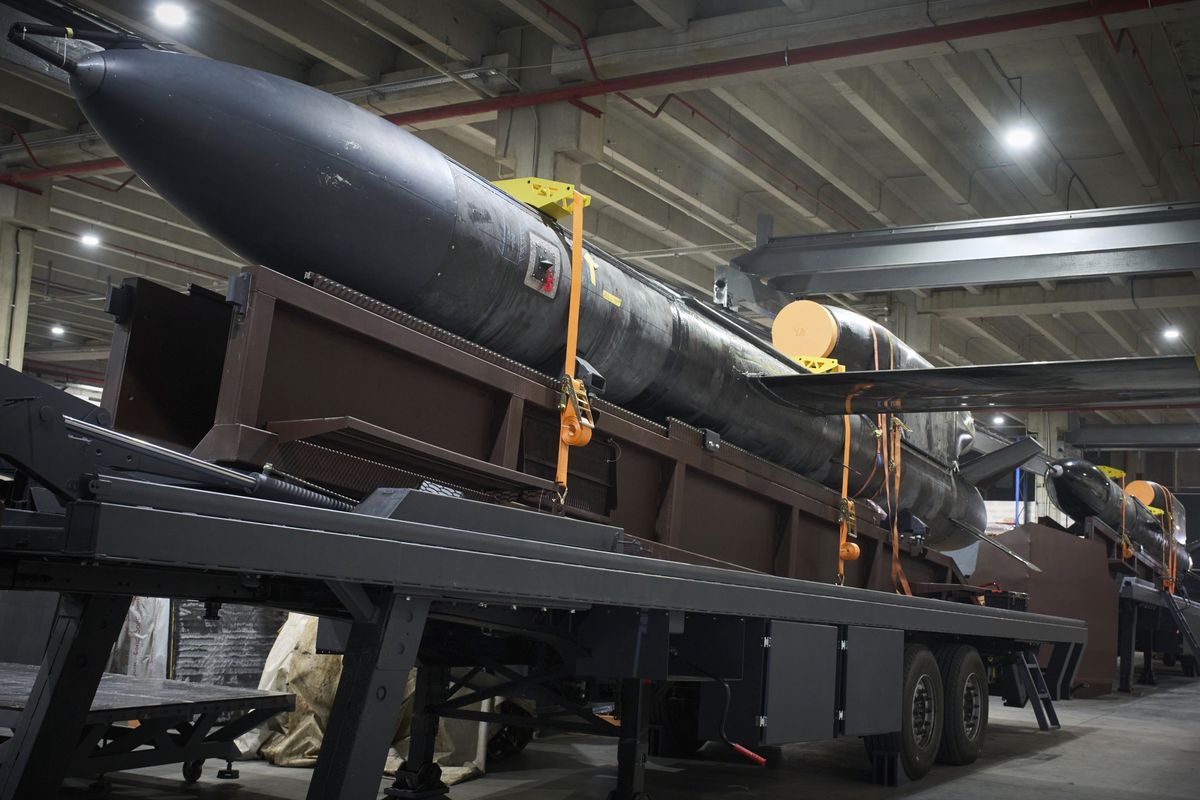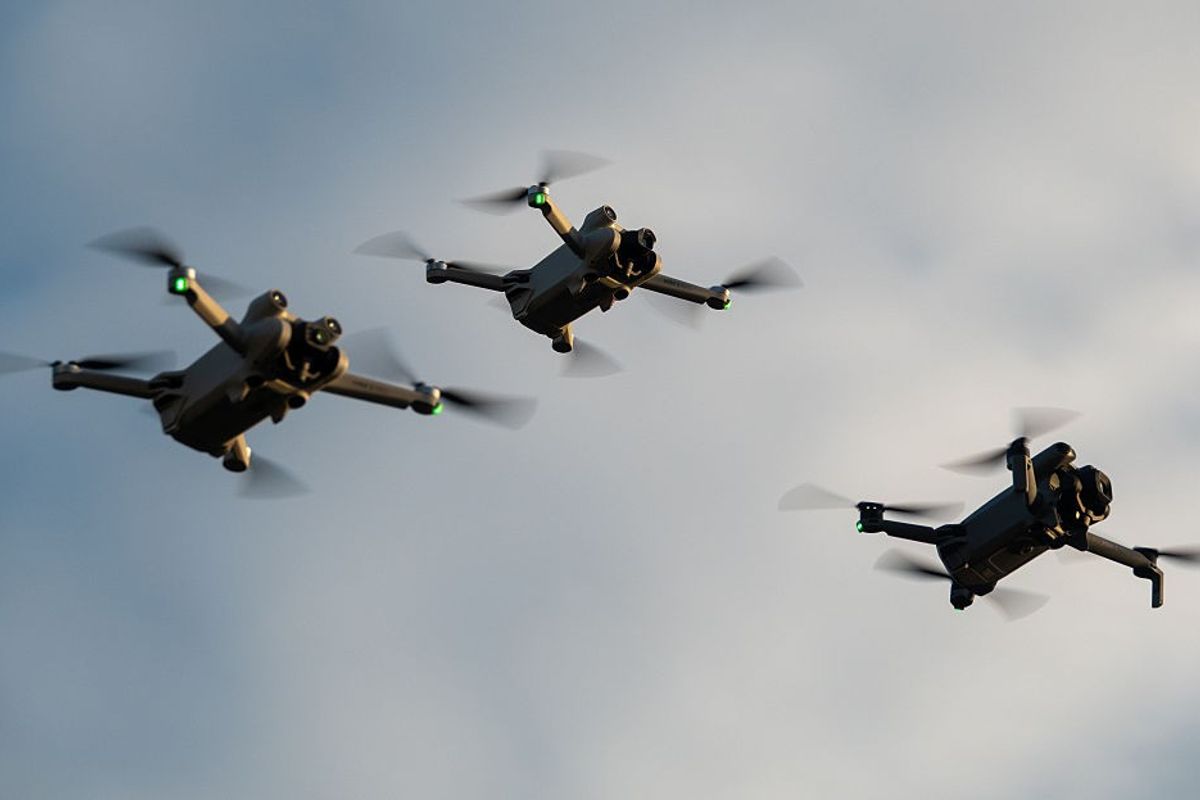EXCLUSIVE INTERVIEW — One of the most profound impacts of the war in Ukraine has less to do with the frontlines and diplomatic negotiations, and more to do with Ukraine’s staggering pace of innovation. Global policymakers, military commanders, and defense industry professionals have remarked on the rate and quality of the country’s weapons production and innovation — particularly when it comes to drones.
It’s a classic case of the axiom that necessity is the mother of invention; when Russia launched its full-scale invasion, Ukraine was badly outgunned on the drone front by Russia, which received large volumes of Iranian-made Shahed drones. But Ukraine has since built up a domestic drone industry that is now the envy of Europe, and closely watched from all over the world.
For their part, American military strategists are concerned that U.S. innovation isn’t where it should be, given that these autonomous weapons are likely to feature prominently in the wars of the future, as much or more than the huge — and hugely expensive — weapons systems that have been staples of the U.S. defense industry. Experts have noted that China far outpaces the U.S. in the production of drone weapons and components, and some have worried about the slow pace of approvals and procurement in the American system.
“The military is a very risk-averse organization, and justifiably so — when the military fails, the nation fails,” Air Force Colonel Maximilian Bremer, Chief of the Advanced Program Division at the U.S. Air Mobility Command, told The Cipher Brief. “There has to be a certain amount of risk aversion, but there is a big difference between acute risk aversion and chronic risk aversion.”
Kelly Grieco, a senior fellow with the Stimson Center, echoed the point. “We need to acknowledge that we are facing adversaries that are adaptive and creative,” Grieco told The Cipher Brief. “American ingenuity has always been one of our core strengths.”
Leveraging that ingenuity is at the core of the work of the Defense Innovation Unit (DIU), a Defense Department group which is tasked — as its website puts it — with “accelerating the adoption of commercial technology at speed and scale,” to boost the pace and quality of U.S. innovation in the military sector. DIU’s flagship drone program is known as Blue UAS, which vets and approves commercially available small unmanned aircraft systems (UAS) for the military.
This week The Cipher Brief spoke with Trent Emeneker, the project manager for Blue UAS. He acknowledged the challenges his unit and the military face in acquiring the drone capabilities at the rate and scale needed for the U.S. military to stay competitive.
“Within DoD today, if we were to exhaust our platforms at the same rate Ukraine does, the entire DoD inventory goes away in less than four days,” Emeneker said. “And we don't have a production capacity to rebuild that.”
Emeneker spoke with Cipher Brief COO Brad Christian. Their conversation has been edited for length and clarity. You can watch the full interview on our YouTube channel.
The Cipher Brief: Could we start with a general, high-level view of what DIU is focused on in this area?
Emeneker: DIU is not focused on anything in particular. We are here to respond to emerging capability gaps that the warfighter has. We go out to commercial partners or industry, find technology that can – if not solve — at least help mitigate or address those issues and bring them to bear within DoD on a commercial time frame measured in months, rather than a traditional program or record approach, which is measured in a decade.
The uncrewed system space in general — that's ground, maritime and surface drones, and counter-electronic warfare — is a huge point of emphasis for DIU today. And that is because across DoD, end users are very clear about the capability gaps they have. They don't have ways to address what they know would be a need in a conflict with a peer. So that's what we're trying to do and what we're trying to go for.
I am the Blue UAS project manager. Blue UAS is a third entry point into DoD for uncrewed systems. Normally in DoD, you can enter via a program of record, or an exception to policy, which is a very paperwork-intensive, tedious process with a lot of restrictions. Blue UAS was created about five years ago to go to the commercial market, and verify and validate that components were in accordance with the law. There's various pieces of legislation to cover that, but essentially when we say in compliance with the law, we mean certain components can't come from China, Russia, North Korea, Iran, or a couple other countries. In this space, China makes 90-plus % of the global market, not just in drones but the key components as well.
Then we do a cybersecurity analysis, which allows us to generate a piece of paper called an Authority to Operate (ATO). That ATO is what allows for use of our UAS platforms by operators across all of DoD without doing any other paperwork. If they have the funds, they can go buy the platform or capability that they need if it's on the Blue List. It's legal, it's fast. From start to finish, if there is an emerging need that a DOD end user comes to us and says, Hey, we have a problem and we already have the capability, or Hey, here's the specific thing we need, in 45 days or less, we can do that process — verify, validate, and add it to the Blue List — which then allows them to go out legally purchase it. It shortens, often by three orders of magnitude, the time frame required for traditional response.
We're not the deciders. We choose things from the commercial market, but it's done by evaluators from across DoD.
The Cipher Brief: Can you provide perspective on the diversity of platforms that are currently in use across the military?
Emeneker: From where we sit, uncrewed systems have changed the way wars are fought, period. There are fundamental changes in the way wars are fought at the tactical edge.
Within DoD, we do not have platforms at mass, at quality, or at producibility scales that would be needed in a true peer conflict. In Ukraine today, it’s a conservative estimate to say they are expending more than 150,000 UAS platforms a month. It will be somewhere north of 2 million this year, if the war continues. Within DoD today, if we were to exhaust our platforms at the same rate Ukraine does, the entire DoD inventory goes away in less than four days. And we don't have a production capacity to rebuild that. Four days in a conflict against a near peer, and that's it.
A trusted colleague of mine recently visited a company in Ukraine that has the capacity to make more than 4,000 drones every day, dependent on supply chains. In this fiscal year, the entire DOD plans to buy less than 4,000 drones. The math just doesn't add up. We are not preparing for the contested future that we have to. And the unfortunate truth is if we're called to go into combat, that 19-year-old kid on the front line is going to pay the price in blood. So that's what drives DIU, the team working on things from our end. We have to do better. That 19-year-old kid deserves the best.
To date, powers allocating money and budgets within services have not made it a priority. We hear lip service paid to this. We don't see action. I can tell you that folks on the front lines know what they need. They are very clear about it. They're not getting it. I hear that on a daily basis.
The Cipher Brief: Is it just a mindset problem? Is it just that simple?
Emeneker: I wish I could say it's a simple problem. We can separate it into three key things. Number one, there's policy. Policy is set by Congress. We know there are interested people in Congress. But today, there are still some things that haven't been addressed. DJI, the dominant Chinese giant in this industry, controls somewhere north of 80% of the global UAS market. Chinese supply chain manufacturers in this space, 90-plus %. And depending where you look, it’s approaching 100% for certain key things. So there's the policy piece.
The hardware piece is that things are made in China. I am never going to undersell American ingenuity, capitalism, and the way we can respond, because we can. But to build a factory, to work out the bugs in production, to hire and train a workforce, we can't do that overnight. It takes time. And what our commercial partners tell us repeatedly is, if we give them firm demand over a period of years, then they can unlock the capital needed to invest. But they can't do it without that, because otherwise they're going to go out of business.
Then there's software. How do you integrate software capabilities to unlock the potential and ease of use and operability by that end user to solve the problems they have on the battlefield? We know electronic warfare is pervasive. We know that there's counter-UAS capabilities. If you've been there, you get wet, cold, tired, it's night, things get hard. From where I sit, we have to give the right software to take that cognitive load off the operator to allow them to do what they need to do. It's as simple as maybe an algorithm that helps stabilize the platform when it's flying, or it can detect and classify a thermal signature so that the operator doesn't have to see it and recognize it when it's 3 in the morning, and you're tired because you haven't slept. There's a lot of ways that software comes into play.
One of the other key things that we know from Ukraine is we've seen technological generations roughly every three months since that war started. To react that fast, we have to embed commercial partners and industry directly with our operational end users and allow them to iterate at that speed. We can do it. We have industry partners. We know they can do it.
The Cipher Brief: We have traveled to Ukraine a number of times over the last few years. And we had the pleasure of meeting a number of units and folks that are involved in the domestic drone industry there, which has staggering numbers of production. You mentioned DJI [in China] and the success that they've had on the commercial market. I don't see a concurrent interest in establishing commercial success with our drone industry. Is that a problem?
Emeneker: You're absolutely right. DJI makes an excellent product. They incorporate user feedback, a thriving developer ecosystem. They’re just easy, simple, and effective. And they're cheap. So if you were to compare as best you can, apples to apples, Chinese versus U.S. allies and partners, the cost for that U.S. option versus the Chinese option on the commercial market is 4 to 5 times higher, and it’s probably going to get you something that's not as good. It's not as intuitive. It's harder to work.
This goes back to policy. As long as DJI is the dominant player in the U.S. and the drone industry, we're not going to develop that ecosystem internally. There's just no way you can overcome that. DoD sales in this space represent less than 1% of the total general market sales in the United States on a yearly basis. The math doesn't add up. We see encouraging signs. There's legislation that's been proposed. But from a national security perspective, we do view dependence on Chinese components as a vital threat.
The Cipher Brief: We've talked a lot about Ukraine, but we can't forget that there's other parts of the world. There's been a lot written recently about the U.S. effort to iterate and evolve unmanned systems for the Indo-Pacific region, which are going to require a different approach than Ukraine. Are you involved at all in that?
Emeneker: We are aware of the needs around the world, because combatant commands and services tell us. A recent project that we announced publicly is Artemis, intended for long-range, one-way attack platforms. We have two shorter-range platforms that we selected companies for prototyping, but also two longer-range, as in a thousand-plus kilometers. If you draw a circle on the map in the Indo-Pacific, that becomes operationally relevant.
I am a firm advocate of the fact that the way we fight wars has changed, and in the uncrewed space, mass, affordable, attritable autonomy is what we have to have. So you can't pay $500,000 for a platform. You can pay maybe $50,000 but not $500,000. So we focused on two companies that we’re partnered with, U.S. firms partnered with Ukrainian hardware manufacturers. We think we've chosen a sweet spot of capabilities that can apply in EUCOM, in CENTCOM, and also in INDOPACOM because of their affordability, ease of launch, the fact that they carry the payloads that could be wanted, and they're simple and intuitive and can be dispersed. We think that also answers a need.
That doesn't mean we're right. It doesn't mean we're going to succeed. We're probably going to fail on some of those companies that we selected. That's the nature of choosing and partnering with commercial firms. But we're going to iterate and we think we’ve made some good choices.
The Cipher Brief: What are you going to be looking for over the next 12 months, in terms of milestones and achievements?
Emeneker: We are focused on the gaps that our end users have. If we are called to go into combat tomorrow as a nation, we're going to have people die because they don't have what they need. And so we remain focused on providing them options. Not perfect options, not world-beating options, but options that will allow them to train for, prepare, survive and prevail in combat. That doesn't mean perfect, but it means now. That is something that we focus on all the time.
We are a demand-driven organization. We respond to emerging demand, problem sets, capability gaps from our end user partners. That means we're not picking. But are we aware of what's going on? Yes. Do we closely follow developments in the uncrewed systems, the electronic warfare, the counter-UAS space? Absolutely. And it's fair to say we're going to continue to focus efforts in those three areas.
The specifics, you'll see change. To use last year's Blue UAS list refresh as an example, we conducted a full competitive refresh of all the platforms on the list. End users had been very clear that they needed first-person view or kamikaze drone options, they needed micro- or nano-drone options, and they wanted some group three platforms that had longer time on station or more cargo capacity. We're in the process of adding all of those options to the Blue List. We've also focused on modularity and on bundling, providing options for different radios, sensors, software packages, cameras for folks to pick and choose from in response to their unique needs.
What we don't want to do is say, we know what's best and we're giving you what you want and that's all you get. We want to be a demand-driven organization.
Much in the same respect, if you go to the grocery store, you pick what you want off the shelf. And then if you don't pick it, the grocery store is going to put something new on the shelf in a couple of months to give you a different option. That's the mindset we take. We're not going to get everything right. But we want to be a responsive organization that responds to emerging and evolving needs at the speed they do. And from where I sit, there's just so much to do because we owe more to the frontline soldier. We need to prepare them and equip them for combat, and we aren't doing that today.
Read more expert-driven national security insights, perspective and analysis in The Cipher Brief













